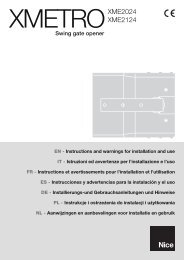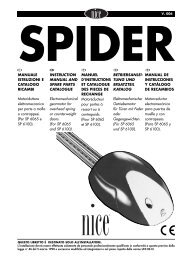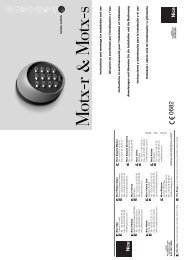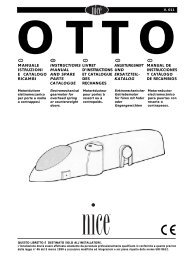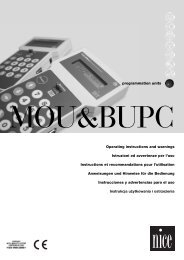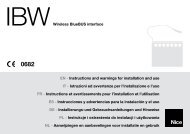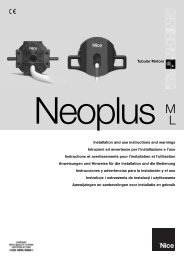MANUALE ISTRUZIONI E CATALOGO RICAMBI ... - Nice-service.com
MANUALE ISTRUZIONI E CATALOGO RICAMBI ... - Nice-service.com
MANUALE ISTRUZIONI E CATALOGO RICAMBI ... - Nice-service.com
Create successful ePaper yourself
Turn your PDF publications into a flip-book with our unique Google optimized e-Paper software.
2.2.4) Checking connections! The following operations entail working on live circuits; most ofthese run on extra-low safety voltage so they are not dangerous butsome are contain mains voltage which means they are HIGHLYDANGEROUS! Pay the greatest of attention to what you are doingand NEVER WORK ALONE!• Power the unit and check that voltage between terminals 5-6 isapprox. 24 Vac.• Check that the “OK” Led flashes rapidly for a few moments andthen that it flashes at a regular frequency.• Now check that the Led’s relative to the N.C. (Normally Closed)contacts are on (all safety devices active) and that the Led’srelative to the N.A. (Normally Open) inputs are off (no <strong>com</strong>mandpresent); if this is not the case, check the connections of thevarious devices and make sure they are in good working order.The STOP input switches off both FCA and FCC.• Make sure the limit switches are connected properly; move thelimit switch lever and check that the relative limit switch cuts inand switches off the relative Led on the control unit.• Release the leaf, take it to the halfway point and then block it; itis now free to move in either the opening or closing direction.• Now make sure that movement occurs in the right direction, thatis, see whether the movement set on the unit corresponds tothat of the leafs. This check is of paramount importance, if thedirection is wrong, in some cases (in the “Semiautomatic” mode,for instance) the “Automatic” system might appear to be workingproperly; in fact, the “Open” cycle is similar to the “Close” cyclebut with one basic difference: the safety devices are ignored inthe closing manoeuvre which is normally the most dangerous,and they will trigger in the opening manoeuvre causing the gateto close against the obstacle with disastrous results!• To see whether or not the direction of rotation is correct, give ashort pulse to the Step-by-Step (PP) input; the first manoeuvrethe unit will carry out after being powered is always an “Open”one, so simply verify that the automatic system moves in theopening direction; if this movement is incorrect, proceed asfollows: Turn the power off Turn the motor and the limit switch power connectors180°. (Ref. “O” and Ref. “V” of Fig.1) Once this has been done, check whether the direction ofrotation is now correct by repeating previous point.The “OK” Led located in the centre of the board has the task ofsignalling the status of the internal logic: regular flashing at 1 second intervalsindicates that the internal microprocessor is active and waiting for <strong>com</strong>mands.When the microprocessor recognises a variation in the state of an input(whether it is a <strong>com</strong>mand or a function Dip-Switch input) it generates a rapiddouble flash even if the variation does not have any immediate effect.Extremely rapid flashing for 3 s means that the control unit has just beenpowered or is carrying out internal testing. Irregular flashing, lastly, means thatthe test has been unsuccessful and that a fault has occurred.GB3) Adjustments:Adjustments can be made with the trimmers that modify thefollowing parameters:Working time (TL):Adjusts the maximum duration of the opening or closing manoeuvre.FTLTPTo adjust the working time TL, select the “Semiautomatic” operatingmode by moving Dip-Switch 1 to ON and adjust the TL trimmer tohalfway along the travel distance. Then run a <strong>com</strong>plete openingcycle followed by a <strong>com</strong>plete closing cycle and readjust the TLtrimmer in order to leave enough time for the whole manoeuvre plusa margin of about 2 to 3 s.If the trimmer is at maximum and there still is not enough time, cutthe TLM jumper on the printed circuit between the TL and the TPtrimmers in order to provide more working time.Pause Time (TP):In the “Automatic” mode, this adjusts the delay between the end ofthe opening manoeuvre and the beginning of the closing manoeuvre.To adjust Pause Time TP, select the “Automatic” operating mode bymoving Dip-Switch 2 to ON and adjust the TP trimmer as required.Then carry out an opening manoeuvre and check the time elapsedbefore “Automatic” closing manoeuvre.TLMForce (F):Fitted on the control unit, this adjusts maximum Force.Take great care when adjusting the Force (F) trimmer as this mayaffect the level of safety of the automatic system. Trial by error isrequired to adjust this parameter, measuring the force applied to theleaf and <strong>com</strong>paring it with regulatory values.In the RO1010 and OT21 control units, Force is adjusted with amulti-position Switch located on the casing of the control unit powertransformer.9



